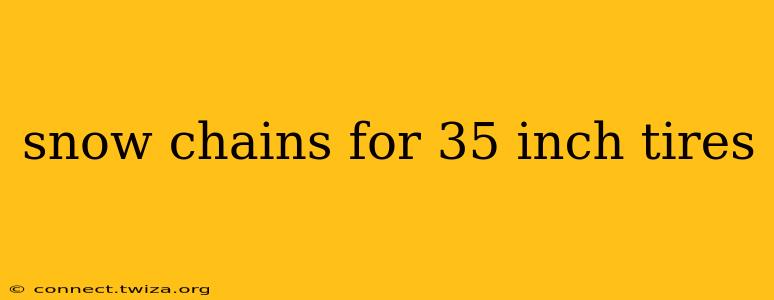Driving in snowy or icy conditions can be treacherous, especially with larger tires like 35-inch ones often found on trucks and SUVs. Proper traction is paramount, and snow chains are a crucial safety device in these situations. However, finding the right snow chains for 35-inch tires requires careful consideration of several factors. This guide will walk you through everything you need to know to choose, install, and use snow chains effectively.
What Size Snow Chains Do I Need for 35-Inch Tires?
This is the most important question, and the answer isn't a simple "one size fits all." 35-inch tires aren't a standard size, and different manufacturers use slightly varying dimensions. You MUST check your tire's sidewall for the exact tire size designation (e.g., LT315/70R17). This precise information is crucial for selecting compatible chains. Don't rely solely on the overall diameter; the width and aspect ratio are just as vital. Incorrect sizing can lead to damage to your vehicle or ineffective traction. Always consult the snow chain manufacturer's compatibility charts to ensure a proper fit.
What are the Different Types of Snow Chains for 35-Inch Tires?
Several types of snow chains cater to different needs and driving styles:
-
Traditional V-Bar Chains: These classic chains offer excellent traction on packed snow and ice. They are typically more affordable but can be noisier and potentially harder on your vehicle at higher speeds.
-
Cable Chains: These chains are lighter, quieter, and often gentler on your vehicle than V-bar chains. They provide good traction, especially on packed snow and ice, but may not perform as well as V-bar chains in deep snow.
-
Non-Slip Chains: Sometimes called "sock-style" chains, these are easier to install than traditional chains. However, they generally offer less traction than V-bar or cable chains and are best suited for less severe conditions.
-
Automatic Snow Chains: These chains automatically deploy on the wheel to provide superior traction, improving road safety. However, they are often more costly than traditional chains.
How Do I Install Snow Chains on 35-Inch Tires?
Installing snow chains correctly is vital for safety and effectiveness. Always consult the chain manufacturer's instructions carefully before attempting installation. Generally, you should:
-
Park on a level surface: This makes installation much easier.
-
Engage the parking brake: This is essential for safety.
-
Locate the chain's tensioning mechanism: This will allow you to adjust the tightness of the chains.
-
Position the chains on the wheel: Work slowly and carefully, ensuring the chains are snug against the tire without being overly tight.
-
Secure the chains: Fasten all connecting links and adjust the tension so that the chains are taut but not too tight.
-
Check for proper fit: Before driving, ensure the chains are correctly positioned and not dragging on any vehicle parts.
Are 35-Inch Snow Chains Suitable for All Vehicles?
While 35-inch snow chains will definitely increase traction for the tires themselves, suitability also depends on the vehicle. Clearance is a major concern. Ensure your vehicle has enough ground clearance for the chains to fit without rubbing on the vehicle body, suspension components, or wheel well. Check for adequate clearance under your vehicle before purchasing.
Where Can I Buy Snow Chains for 35-Inch Tires?
Snow chains are available from various retailers, both online and in physical stores. Popular online retailers include Amazon, and many specialized automotive stores carry them as well. When buying online, always verify the compatibility with your specific tire size and vehicle.
What is the best way to store snow chains?
Proper storage is key to prolonging the lifespan of your snow chains. Clean them thoroughly after use and store them in a cool, dry place to prevent rust and corrosion. A protective bag can help maintain chain integrity and prevent snags.
By carefully considering these factors and following the proper installation procedures, you can ensure safe and effective traction in challenging winter conditions. Remember, safety should always be your top priority.
